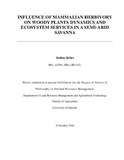| dc.description.abstract | In Kenya, woody plants encroachment has been witnessed in many parts of the rangelands. In the study area (Laikipia county) shrub encroachment in the last half of the Century has increased by more than 25% has been blamed on the management systems in place. This has affected the landscapes‟ ability to provide critical ecosystem services e.g. forages, habitats for wildlife and ecosystem ability to resist invasion among others. This study investigated the effects of livestock browsing intensities on plant traits such as specific leaf area (SLA), leaf dry matter content (LDMC), leaf phosphorus and nitrogen content (LPC & LNC), canopy height (H) among others, functional diversity and ecosystem services (biomass production and habitat invasibility) under lightly browsed private commercial (PR) and intensely browsed pastoral group ranching schemes (GR). Innovations on natural and social capital assets management within pastoral group ranch system were also evaluated.
The vegetation and sites data was collected in 421 plots of 20x20 m each, nested in three transect lines of 3 km long in each ranch, while plant traits and leaf biomass where collected from four predetermined species that were dominant and palatable based on reconnaissance survey. They included; Acacia brevispica, A. tortilis, A. etbaica, and Acacia mellifera. Structural diversity between sites was determined based on coefficient of variation (CV) of vegetation structural attributes such as mean canopy crown cover, mean height etc. calculated as standard deviation divided by mean. Functional traits diversity and Simpson species diversity was calculated using Rao coefficient index formula while Traits Community Weighted Means (CWM) was calculated using the formula. Pearson correlation analysis was done to compare biotic and/or abiotic
xii
factors that may have influenced abundance and distribution of invasive species. Mann Whitney U - test and Z – test were used to test for significance between management systems. The findings show that key innovations in the management of natural capital assets in the pastoral system included establishment of small-scale cultivation, shift in herd species composition to maximize on changing forage resource (more browsers –goats than grazers – cattle), introduction of drought tolerant breeds (e.g. Galla goats) and species (camels), harnessing of wildlife and culture based tourism (Conservancies establishments), leasing and hiring of pastures, expansion of traditional enclosures (Olokerii) among others. Among social capital assets, the establishment of new networks such as business associations (e.g. Bee-keepers), self-help groups governed by by-laws, norms and sanctions replaced weakening traditional networks that were based on clans and age-sets. Vegetative traits varied between the two management systems. Contrary to expectation, aggregated mean values for diameter at knee height (DKH), height (Hc) and crown (CRWN) were larger (Z= 98.3, p<0.05; Z = 98.5, p<0.05; Z= 37.7, p<0.05) in GR than PR respectively. On the other hand, leaf traits recorded variable results. Aggregated mean for specific leaf area (SLA) and Leaf nitrogen content (LNC) were not different between sites (Z = 0.66, p<0.43 and Z=0.44, p<0.76) in GR and PR respectively while leaf area (LA) and leaf phosphorus content (LPC) recorded higher values (Z = 4.9, p<0.05; Z=3.9, p<0.05) in PR than GR respectively. Leaf dry matter content (LDMC) values were higher in GR than PR (Z = 5.46, p<0.05). The PR was more functionally diverse than GR based on Rao coefficient index for binary, categorical and quantitative data. Functional diversity for CRWN, Hc and DKH for the three PR species was more variable than same set of traits in GR species. The three species recorded low FD values
xiii
for most of the analyzed traits except LA an indication of traits homogenization. The GR though higher in leaf production was low in structural diversity and species composition. The highest variation in structural diversity between sites was noted in basal area, canopy volume and canopy area while least variation was noted in herb cover and canopy depth. The GR was low in species composition although majorities were of high forage value. The site recorded high leaf biomass production analogous to „browsing lawn‟ which was attributed to dominance of browsing-tolerant A. mellifera species known to easily replace lost biomass through compensatory growth. On the other hand, PR had higher diversity of species but with a significant presence of evergreen unpalatable species such as Euclea divinorum and Croton dichogamus an aspect attributable to high herbivores forage selection. Furthermore, PR was five times more woody compared to GR making it least suitable for open grassland wildlife species. The two management systems varied in invasive (native and nonnative) species abundance. Pastoral system had higher relative invasive species abundance compared to private commercial ranch. The GR was invaded by the following species; Sansevieria sp, Ipomoea kituensis, Opuntia stricta, O. subalata, and Acacia reficiens. There was a positive relationship between abundance of Ipomoea kituensis species with proximity to homestead while Sansevieria volkensii increase away from homestead. The most dominant invasive species at the PR was evergreen Euclea divinorum and was weakly associated with high species rich plots. In conclusion, innovative approaches currently being applied in the management of natural and social assets management have both positive and negative socio-ecological effects. The increasing shift from keeping more grazers (e.g. cattle) to more of browsers (e.g. goats and camels) among the Laikipia Maasai was informed by their higher
xiv
survivorship during drought events but also to increasing availability of browse forage. Intense browsing in GR was effective in keeping check on browsing-sensitive woody species in the absence of fire. This implies that management of livestock browsing intensity can be used to manipulate species composition,density as well as functional diversity. Habitat invasibility is influenced by browsing but mediated by other factors such as soil properties (e.g. soil texture, nutrients etc.). The study findings suggest that group ranching is more socio-ecologically resilient than private ranching and policy options should be explored to strengthen its adaptive capacity. | en_US |



